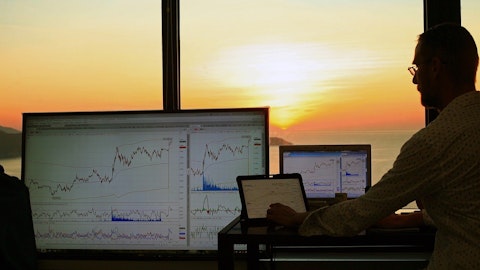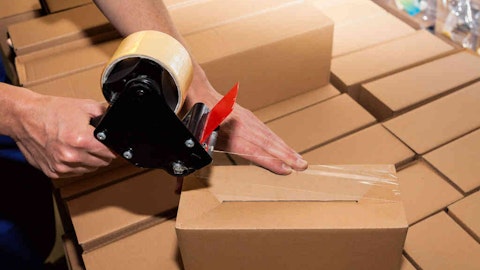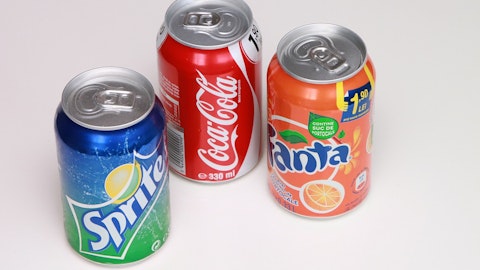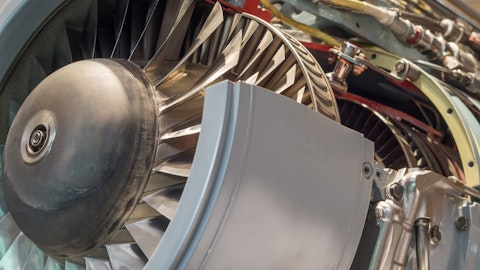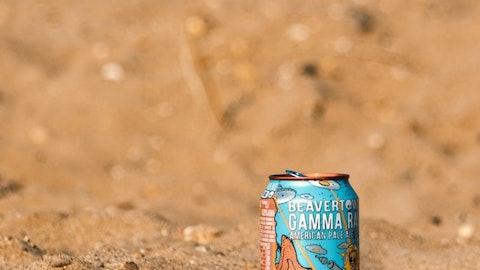Ball Corporation (NYSE:BALL) Q2 2023 Earnings Call Transcript August 3, 2023
Ball Corporation beats earnings expectations. Reported EPS is $0.61, expectations were $0.6.
Operator: Greetings. And welcome to the Ball Corporation 2Q 2023 Earnings Call. During the presentation, all participants will be in a listen-only mode. Afterward we will conduct a question-and-answer session. [Operator Instructions]. As a reminder, this conference is being recorded, Thursday, August 3, 2023. I would now like to turn the conference over to Dan Fisher, Chairman and CEO. Please go ahead.
Dan Fisher: Thank you, Malika. Good morning, everyone. This is Ball Corporation’s conference call regarding the company’s second quarter 2023 results. The information provided during this call will contain forward-looking statements. Actual results or outcomes may differ materially from those that may be expressed or implied. Some factors that could cause the results or outcomes to differ are in the company’s latest 10-K and in other company SEC filings, as well as company news releases. If you do not already have our earnings release, it is available on our website at ball.com. Information regarding the use of non-GAAP financial measures may also be found in the Notes section of today’s earnings release. Historical financial results for the divested Russia operations will continue to be reflected in the Beverage Packaging EMEA segment.

Pixabay/Public Domain
See Note 1, Business Segment Information, for additional information about the sale agreement and a quarterly breakout of Russia’s historical sales and comparable operating earnings. In addition, the release also includes a summary of non-comparable items, as well as a reconciliation of comparable operating earnings and diluted earnings per share calculations. Late in the quarter, the company also announced that is considering options for its aerospace business. There are limitations regarding the depth of commentary we will provide on that topic today. If and or when additional comments are necessary, they will be made via a separate public press release. Joining me on the call today is Scott Morrison, our Executive Vice President and CFO.
I’ll provide some brief introductory remarks. Scott will discuss key financial metrics and then we will finish up with closing comments. Our outlook for the remainder of 2023 and Q&A. Let me begin by thanking our employees for working safely and with the utmost level of agility while fulfilling our customers’ needs. On our first quarter call, we said that our second quarter would be choppy and that was the case. Our team delivered solid second quarter results amid tough year-over-year comparisons, including $47 million of higher interest expense, the $40 million of operating earnings headwind from the Russian sale and global beverage volumes down 11% driven by the Russian sale impact and a notable domestic beer brand experiencing demand disruption in North America.
I’m proud to say that our team did an excellent job of managing both costs and working capital levels to deliver the quarter and position the business for a stronger second half. Looking forward, we will continue to benefit from notable inflation recovery, cost-out actions, and improved operational efficiencies. Our inventory levels are in good shape with plans to improve further. Our North America team is managing in real-time the balance of the U.S. mass beer brand [Indiscernible] and our improved demand forecast of other customers which should unlock additional opportunities during the second half. Cash flow is kicking in and we are studying opportunities to accelerate deleveraging and the multi-year return of value to shareholders, while also developing additional innovative packaging solutions to grow the business going forward.
Around the globe, beverage cans continue to win relative to other substrates and we continue to leverage the contributions of our two new facilities in India, our customer mix, scale, plant footprint, innovation, and capable teams across the organization to ensure the best outcomes for all our stakeholders. In our aerospace and aluminum aerosol businesses, operational performance and demand for our products continue to grow. In aerospace, our one-not-book backlog increased one billion and the unique technologies we provide to support environmental and national security needs remains in high demand. And in our global aluminum aerosol business, we continue to serve new categories and offer reuse, refill bottle innovations to a broader set of customers and occasions.
As we look ahead, all of our businesses will continue to unlock additional value for Ball stakeholders in 2023 and beyond. Consistent with our prior commentary, in 2023, we remain positioned to deliver approximately $750 million of free cash flow to deleverage and return value to shareholders, and in 2023, we anticipate the potential of achieving the low end of our long-term goal of 10% to 15% comparable diluted earnings for share growth, including the Russian business sale headwind and exceeding that long-term comparable diluted EPS growth goal, excluding the Russian sale headwind. During the Q&A, Scott and I will strive to provide additional clarity on the external environment and cadence for the remainder of 2023 based on what we know today.
Our global beverage teams continue to position our businesses to deliver the year and have an eye on the future. For the full year and incorporating year-to-date trends, our customer mix and excluding Russia, we now estimate flat global volume growth for Ball, with North America being down low single digits, South America volume up mid-single digits, and EMEA volume up mid-single digits. We appreciate the work being done across the organization and extend our well wishes to our employees, customers, suppliers, stakeholders, and everyone listening today. With that, I’ll turn it over to Scott.
Scott Morrison: Thanks, Dan. Second quarter of 2023 comparable diluted earnings per share were $0.61 versus $0.82 in the second quarter of 2022. Second quarter sales decreased compared to the same period in 2022, primarily due to the sale of our Russian business in the third quarter of 2022, lower volumes, currency translation, and the pass-through of lower aluminum prices, partially offset by the pass-through of inflationary costs. In the second quarter, net comparable earnings decreased compared to the same period in 2022, primarily due to higher interest expense, the headwind from the sale of our Russian business in the third quarter of 2022, and lower volumes, as well as higher corporate costs, partially offset by the contractual pass-through of inflationary costs, fixed cost savings, lower depreciation expense, and SG&A cost out initiatives.
To reiterate our prior earnings call commentary, we have been and will continue to proactively manage regional supply demand balance across our system of plants in the near term. Starting in the third quarter, segment earnings in North America will accelerate through the majority of the anticipated contractual inflation recovery, having kicked in July 1. In EMEA, the business will lap its last Russian earnings headwind in the third quarter, and then accelerate to an improved level of earnings in the fourth quarter as they move beyond this multi-quarter headwind and the start of costs for the two new plants. In South America, customer and product mix, which has unfavorably influenced the seasonally slower second quarter, will reverse and consistent with our prior commentary, we anticipate a more robust second half in Brazil as customer hedges roll off and the fourth quarter summer selling season kicks in.
As we sit here today, some very consistent commentary and key metrics. We ended the second quarter in a very solid liquidity position with approximately $2.65 billion in cash and committed credit facilities. 2023 CapEx will be in the range of $1.2 billion, driven by cash outflows related to prior year’s projects. 2024 CapEx is targeted to be in the range of GAAP D&A levels. We are targeting free cash flow of approximately $750 million in 2023 and focusing on deleveraging. Our 2023 full year effective tax rate on comparable earnings is expected to be in the range of 19%. Full year 2023 interest expense is expected to be in the range of $450 million. We anticipate full year corporate undistributed costs recorded and other non-reportable to be in the range of $80 million.
Including the $86 million Russian business sale operating earnings headwind, comparable operating earnings should increase nearly $200 million. And full year 2023 comparable D&A will likely be in the range of $550 million. As we look forward to incorporating near-term demand trends, year end 2023 net debt to comparable EBITDA is expected to trend in the range of 3.7 times. And in future years, we will drive that lower. Last week, Ball declared its quarterly cash dividend. And as Dan mentioned, reducing leverage is our key focus prior to resuming share repurchases. As fellow owners, we continue to manage business through the lens of EVA and cash stewardship and we will effectively manage our supply chain and customers in this current environment to secure the best cash earnings and EVA outcome for our shareholders.
With that, turn it back to you, Dan.
Dan Fisher: Thanks, Scott. We continue to believe that given the economic environment and global dynamics impacting our world, it is a great time for investors to get up to speed on Ball. Our improved results following the challenging 2022 is progressing. Our products and technologies are resilient and provide solutions for our customers. Our focus remains on delivering earnings, free cash flow and high quality products to our customers and consumers. And as leverage continues to come down and free cash flow expands, our return of value to shareholders will grow in 2024 and beyond. Thank you to everyone listening today. And with that, Malika, we are ready for questions.
Operator: Thank you. [Operator Instructions] Our first phone question is from the line of George Staphos with Bank of America. Please go ahead. Your line is open now.
See also 12 Best Growth Stocks Under $10 and 10 Best Small Cap Agriculture Stocks To Buy.
Q&A Session
Follow Ball Corp (NYSE:BALL)
Follow Ball Corp (NYSE:BALL)
George Staphos: Hi, thank you. Hi, everyone. Good morning. Thanks for the details, and congratulations on the performance. I guess, the first question I had, can you talk — I haven’t tried to reverse engineer the full-year volume guidance relative to the year-to-date, but what kind of volume trends are you seeing early in the third quarter across the region? And are there any regions left with any notable filled product that needs to be destock? How would you — have you think about that, guys?
Dan Fisher: Yes, thank you. In the mass beer space, I think you’d have to look at that on a net basis. Clearly, there’s one customer that’s got more filled goods right now than the others, and I think they’ve commented on that. There is a little bit within our portfolio in terms of the energy space where we’re working through some inventory. Our largest energy customer in our space in North America is growing at a slower rate than the balance of that space. And so, the scanner data is reflecting more growth than our shipment sales. That normalizes, we believe in Q4 based on the projections that we have. Nothing notable. We’re in a really good inventory spot, George. You can see that reflected in our cash generation in Q2. You always have, this is the softer period for South America, so there’s nothing really of news there.
We expect to start building inventory here in the quarter to execute against the back half of the quarter and then peak season for that part of the world. So absent the obvious mass beer player, not as much.
George Staphos: Okay. And actually, what I was getting at to some degree was what you were seeing in South America. So in South America, you — from your vantage point, not a big amount of de-stocking, if anything, that needs to get done at the customer level. That would be fair?
Dan Fisher: No, we’ve been running.
George Staphos: Other than you large — I’m sorry, go ahead.
Dan Fisher: Yes, that’s correct. There’s nothing meaningful in South America. You always run to get, you’re always doing maintenance and there’s always a level of curtailment in Q2. And so, there’s just not a lot of room to run additionally to build inventory, because you’re already planning that you’re going to be running full out in Q3. The inventory builds, if you have that effect, typically it shows up at the end of our fiscal year down in South America. If things aren’t selling through in Q4, you usually have a bit more inventory heading into Q1. So we’re in a really good position inventory-wise. That was something that we commented heading into the quarter. The teams and the plants managed that tremendously, even with the mass beer inflection that showed up in the quarter and persisted throughout the quarter.
George Staphos: Okay, Dan, thanks for that. I want to sort of come back to part of the question as I asked it and ask you to follow and then I’ll step down just to be fair to everybody else. So what trends are you seeing early in the quarter volume-wise across the regions if you can talk about, put a number on that if that’s possible? And then from our research and contacts, we’ve seen an uptick in promotional activity. We haven’t necessarily seen a pickup in consumption yet. How would you have us think about the efficiency and the yield on promotion and the level of promotion that you’re seeing into 3Q? And are we beginning to see some finally, some uptick in beer just based on what we’re seeing out of the scanners and why, if that’s the case, would you be confident about that continuing the rest of the year? Thank you.
Dan Fisher: Yes, that’s a good question. Let me see if I can parse out the elements of that. Let’s look at North America. There’s nothing really to report in terms of inflection one way or another in South America because it’s still winter there. We wouldn’t see that behavior until the second half of Q3. So nothing to report other than the conversations that we’re having with our customers. Again, I’ll be down there next week. They’re planning to deliver against what we’ve modeled in right now, which is a pretty nice inflection of volume heading into Q4 Brazil. We’ve comment on this previously. Bullish on the Brazil — Brazil was the first to go into a recession and experience inflation and higher interest rates. They’re starting to relieve some of that.
